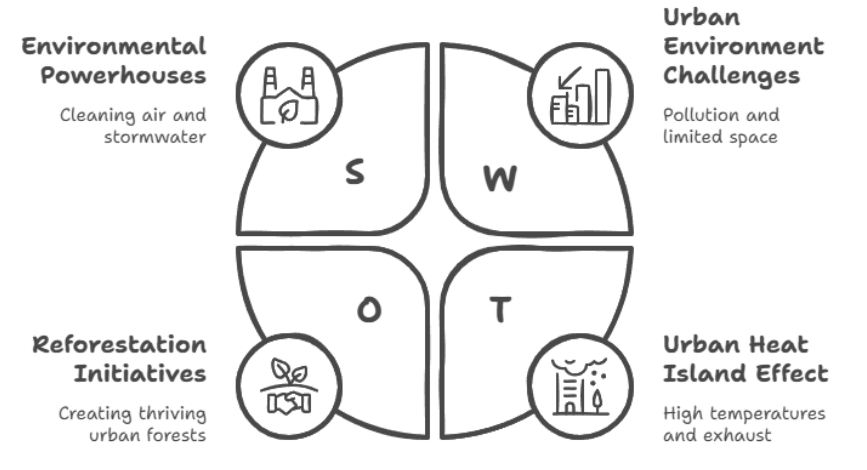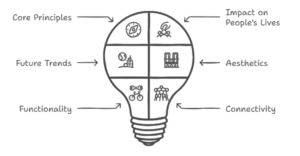
Isn’t it kind of amazing that a strategically placed tree can actually lower a city’s average temperature – sometimes by as much as 7°F? It’s not just about shade on a sweltering day (though goodness knows, we all appreciate that!). City trees are basically environmental powerhouses: cleaning the air, sopping up stormwater runoff… they can even boost your property values. But, of course, life in the concrete jungle isn’t a walk in the park for our leafy friends, you know? They often struggle with pollution, limited space, and ridiculously compacted soil.
I’ll never forget driving through Pittsburgh, it must have been almost a decade after they launched this really ambitious reforestation initiative. I was honestly floored. It was a total transformation: the industrial landscape that I was kind of expecting was actually surprisingly vibrant, teeming with green. It hit home how crucial it is to pick the right urban trees if we want those thriving urban forests and all the perks they bring. So, in this article, I’m basically sharing my insights to hopefully help you choose the best trees for YOUR urban environment, so you can get started creating your own little green oasis. (And who wouldn’t want that, right?)
Understanding the Urban Environment
If you want to pick the right trees, you have to understand the, shall we say, “less-than-ideal” realities they face in our cities. Try to remember the last time you stepped on hot asphalt radiating heat on a summer day – that’s the urban heat island effect in real life, and it can push temperatures WAY above what you’d find in the countryside. Then, factor in the exhaust from cars and industry… it hangs in the air and coats leaves, which really actually makes it hard for the tree to do its photosynthesis thing.
And under the ground, things are sometimes even worse. The act of constantly building and driving on soil compacts it, which leaves, if you think about it logically, very little room for roots to kinda breathe and stretch out – this definitely leads to root restriction which is definitely not a good thing. Oh, and don’t forget the wonderful winter salting of roads. Salt damage is no joke and it puts even more stress on trees that are, you know, already struggling.
Basically, the urban environment, for a tree, is like some kind of challenging obstacle course. They’re constantly dealing with conditions that are just… unnatural. But that is why it’s so important, and recognizing the challenges is the first step to select various species that can handle the conditions, thrive, and make our cities greener.
Key Considerations for Choosing Urban Trees
Okay, so how do you pick the right tree? It’s not always super obvious, tbh. Here is a simple checklist for you:
- Mature Size: It’s easy to only think the sapling you’re planting, but remember to think through ten, twenty, or even fifty years. You’ll need to ask yourself questions like: Will it outgrow the space? Block sunlight? Interfere with certain power lines? Always think of both the entire width AND height to avoid problems in the future.
- Hardiness Zones: Here is when the USDA Plant Hardiness Zone Map planthardiness.ars.usda.gov will be your best friend. Before selecting a tree, consult a map to figure out the area your new tree will be in at, this will allow you to select the right tree.
- Soil pH and Tolerance: The soils in cities are less than perfect. Understand your soil’s pH, acidity or alkalinity, is a must, especially when thinking through soil conditions. There are some trees that prefer acidic and some that prefer alkaline.
- Maintenance and Other Issues: What about the pest resistance of the tree? You should consider maintenance costs and susceptibilities to diseases down the road. Choosing native species saves time and money.
If you want to make well-informed trees that can thrive in challenging areas, you need to consider these factors. When thinking through the meters, convert feet like this: 1 foot equals 0.3048 meters.
My Top Picks for Urban Trees
So, based on my own past experiences, I am confident to say that the trees listed will thrive even in tough areas:
Small Trees for Tight Spaces
There are certain times when space is limited yet beauty is still desired.
- Crabapple (Malus spp.): You absolutely cannot go wrong with the classic crabapples. They give you lots of wonderful blossoms to make it through the spring of the shades of white, red or pink. The fruits also stay during the winter which provides birds food and gives you something to look at. I personally like Prairifire because it resists disease and has such stunning red foliage.
- Dogwood (Cornus florida): Any urban landscape welcomes dogwoods for their vibrant color and uniquely shaped flowers. They do like the soil to have some acidity and enjoy moderate shade. Cherokee Brave is a cultivar and is great with red bracts that are on the deeper side.
- Japanese Maple (Acer palmatum): You can find zen in the city with a Japanese maple. They boast a delicate foliage that always visually stuns. They come in red, green, and purple (many shades) and require soil that drains well and moderate shelter from sun.
Medium to Large Trees for Shade and Beauty
- Oak (Quercus spp.): The oak is a majestic tree that is durable and gives great shade. It’s adaptable and drought tolerant too. It’s tough enough to thrive despite soils that are compacted or pollution.
- Maple (Acer spp.): The maple tree colors gorgeously in the fall. One species, red maple Acer rubrum, is great. Just make sure to select something that goes well in your area to avoid as much upkeep as possible.
- Linden (Tilia spp.): You cannot go wrong with a Linden. Its fragrant flowers look stunning and it provides shade. The conditions do not impact this tree too much. Littleleaf Linden is great when working with smaller spaces.
Trees for Specific Challenges
I’ll be honest, not every tree can handle tougher, specific situations. Some are up to the task. Here are the trees for that:
- Callery Pear (Pyrus calleryana): Even with invasiveness impacting certain areas, Pears are usually quite popular for having tolerant pollution and great soils. You can plant them practically everywhere. A commonly planted cultivar is Chanticleer. Contact your local extension office about this tree and its statuses.
- Goldenrain Tree (Koelreuteria paniculata): This is a very hardy tree that will do great in any condition. They are definitely great in cities.
- Ginkgo (Ginkgo biloba): This ancient beauty boasts great pest resistance and tolerance to pollution in the air. Look at the male trees to avoid fruit.
Make sure to contact an accredited arborist about planting and which trees are right for you.
Planting and Care Tips for Urban Trees
The urban tree costs a lot so you should give the sapling the best shot that you can. I personally have a lot of experience with this, so here are some tips that I have:
- Soil Preparation is Key: In order to get your soil tested, it’s pretty simple. This will demonstrate the amount of nutrients and pH in the soil and let the soil be amended accordingly. You should dig a hole that is twice as wide. but no deeper, than the ball of roots. You want to improve the soil by doing whatever you can to it – with some organic matter the aeration and drainage will be better for roots.
- Planting Depth Matters: A mistake I always see is that the planting is too deep. The top of ball needs to level. Make sure to have any circling roots loosened prior to placing the new tree in the hole. Always check prior!
- Watering Wisely: Water often. The ball will need soaking, but make sure to not over water or rot will occur. During the hot weather, I always try to water at least once per week. Target water on the rootball!
- Mulch and Protect: Put at least 2 inches of mulch around the bottom, while having inches between the trunk and the layer. The moisture will be retained by the mulch so moisture lasts, the temp will be better, and weeds get suppressed.
Common Mistakes to Avoid
Through all my years planting trees, there are definitely well-intentioned plans gone awry. But some bad things, you know, repeatedly stick out. Avoiding these can really make a tree thrive as much as possible.
- Improper Planting Depth: I mentioned that this point leads to root rot and is a disaster. Too shallow will dry out roots. You need to get the depth just right!
- Ignoring Girdling Roots: Here is when the roots choke the tree by circling the trunk. Typically this happens if the tree is in containers for too long. Always inspect before and prune extra roots.
- Planting the Wrong Tree in the Wrong Place: I saw a tree grow under power lines one time. Make sure it’s going to be planted in a good space!
Resources for Selecting and Planting Urban Trees
You do not need to do it all alone. There are many resources out there to select the correct tree! Tree nurseries know tons about the local trees.
Any cities have forestry departments in urban settings, online databases, as well as the American Forests organization. These resources can guide you through the process as you think and grow!
Ultimately, planting trees in cities does more than add greenery, it is sustainable and environmentally responsible. You can establish amazing, healthy spaces by thinking through species and unique issues that are impactful. These spaces benefit your community for many generations! You absolutely want to work to help transform cities.
